Bumblefoot in chickens, the risks, treatment and prevention

Table of Contents
- What is Bumblefoot in chickens?
- What causes Bumblefoot?
- What are the symptoms of Bumblefoot?
- What happens if you don't treat Bumblefoot?
- How do you treat Bumblefoot?
- What antibiotic treats Bumblefoot?
- Are there natural treatments for Bumblefoot ?
- Does Bumblefoot need to be treated by a veterinarian?
- How long should I keep her feet covered?
- Should she separate her from the rest of the flock?
- Can Bumblefoot kill a chicken?
- Are the eggs laid by a hen with Bumblefoot OK to eat?
- Do chickens have feeling in their feet?
- Is Bumblefoot contagious to other chickens?
- Are some poultry breeds more susceptible to Bumblefoot?
- Why do my chickens keep getting Bumblefoot?
- How do you prevent Bumblefoot?
- Can humans get Bumblefoot?
- Can ducks and other poultry get Bumblefoot?
- What is the prognosis for Bumblefoot?
What is Bumblefoot in chickens?
Bumblefoot, foot bubble or ulcerative pododermatitis, to give it it's scientific name, is a bacterial infection and inflammatory reaction on the feet of chickens. It is characterised by hard round lump in one or sometimes both feet in poultry. It can move into deeper structures like the joints and tendons and even spread into the bloodstream.
Below: Bumblefoot is an infection that causes painful swellings on the feet.
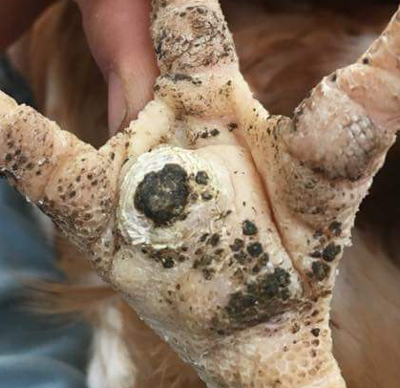
Bumblefoot is result of bacteria like Staphylococcus, Pseudomonas and Escherichia coli (E. coli) forming cysts in the foot tissue. Staphylococcus aureus being the most common cause of the infection. Once the infection becomes established it proceeds rapidly forming a chronic wound and abscess.
The bacteria gain entry through a wound in the foot and cause cysts. They can be in any of the areas of the foot and may get into the joints causing severe pain.
Bumblefoot is more common in backyard flocks and is normally indicative of poor hygiene in the coop and run and bad animal husbandry. It is much more likely in backyard flocks than in commercial enterprises or wild populations and a few simple things could prevent a considerable number of cases.
What causes Bumblefoot?
I get asked a lot if wet ground causes Bumblefoot? The answer is NO, on it's own wet ground does not cause Bumblefoot. It does make it more likely.
Bumblefoot (ulcerative pododermatitis) is more likely to be caused by the sharp or square edges on perches and rough edges on nesting boxes. Pre-built metal nesting boxes are particularly bad for this as they often have fine edges that can cut a chickens foot really easily.
Below: Bumblefoot can infect any part of the foot.
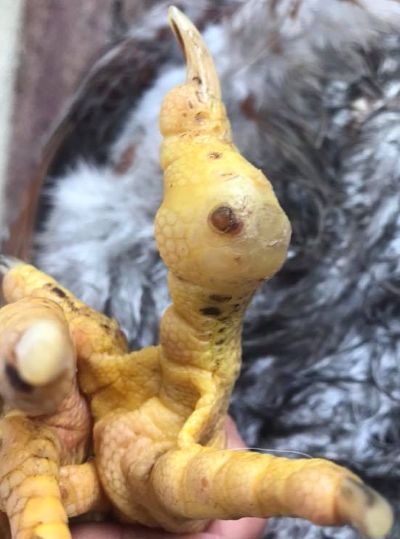
Wild chickens nest on round perches like tree limbs and the ones you provide should be similar.
The risk factors for Bumblefoot or foot-pad dermatitis are:
- Sharp or rough edges on roosts, nest boxes or perches.
- Damp, dirty coops and runs.
- Route of infection like an existing injury to the foot.
- Accumulation of faeces.
- Hard, compacted or muddy run surface.
- Poor diet and vitamin deficiency, particularly vitamin A.
- Genetic foot or leg malformations.
- Fighting or aggression.
- Overgrown toe nails due to inactivity.
- Fat or out of condition chickens that may have suffered from another condition.
- Chickens that have had Bumblefoot before are more likely to get a recurrence.
- Scaly leg mites make Bumblefoot more likely.
What are the symptoms of Bumblefoot?
Bumblefoot is characterised by a large scab on the bottom of the foot, lameness and associated limping, depression and immobility, swelling and smell.
Below: Bumblefoot in chickens.
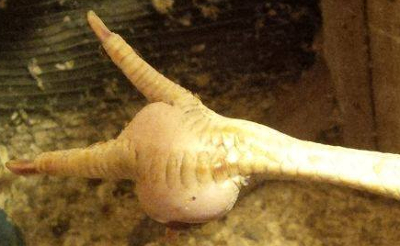
The visible signs of Bumblefoot in chickens include wounds on the feet, abrasions or discolouration. Later symptoms progress through various stages of lameness and hobbling as the infection progresses.
The feet may be hot to the touch which is unusual for chickens and later stages may smell.
Chickens feet should be inspected for signs of small wounds or abrasions to the skin of the feet. Also check that there are no Scaly leg mite or infected feather follicles of the feet or lower limbs.
Diagnosis is by physical and behavioural examination. Looking and feeling the feet and watching the chicken move. Late stage ulcerative pododermatitis may need an X-ray to see it the infection has spread to the joints and bones.
Working out how bad your chickens Bumblefoot is:
Bumblefoot is graded on a scale of 1 to 5 with 1 being the mildest and 5 being the worst.
Grade 1 - The beginnings of Bumblefoot is characterised by a raised shiny patch on the sole of the foot which will have a shiny and worn patch.
Grade 2 - The start of a sore in the sole off the chickens foot. Start of infection but with no swelling of the foot yet.
Grade 3 - Formation of the abscess. Swelling will be visible on the pad and you may not even notice the bird limping. Necrotic or dead tissue is present with a butter or cheese like appearance. It will likely begin to smell as well.
Grade 4 - Infection and swelling of the tissues and structures in the foot like tendons, joints and bones. It is now a chronic wound that will not heal on it's own
Grade 5 - Permanent and crippling infection of the foot. Infection may be so bad it spreads thought the foot and can be seen from above as well as below.
What happens if you don't treat Bumblefoot?
If Bumblefoot is left untreated it can develop into a sore that can consume the whole foot and cause crippling lameness.
Below: Untreated bumblefoot can infect the whole foot and then kill the bird. This is a really bad infection.
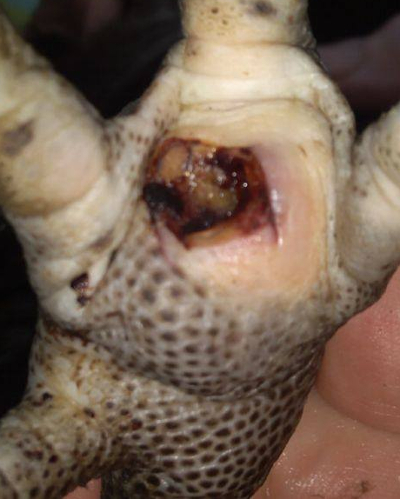
Bumblefoot rarely heals on it's own because of the slightly odd make up of a chickens legs and feet. You will probably end up with a completely lame bird that is in constant pain.
The length of the claws suggest a problem with the way this chicken is kept. Scratching should keep the claws short otherwise they should be trimmed and examined at regular intervals.
How do you treat Bumblefoot?
Treating Bumblefoot starts by wrapping the chicken in a towel to keep it in the dark and stop it flapping and hurting itself or you.
Treatment depends on the severity of the infection. In the early stages use natural home remedies as detailed in the next section below.
At it's simplest the treatment for Bumblefoot consists of emptying the cavity in the foot, cleaning the wound and covering with a sterile dressing.
When it comes to the stage of needing to remove the infection from the foot then it really need to be a veterinarian that does the job.
The 4 stages of treatment are:
Stage 1 - Cleaning the foot and soaking with Epsom salts and warm water to remove the scab. Veterinarians may recommend soaking the foot in a solution of Tricide Neo or similar antibiotic treatment.
Below: Remove the scab and evacuate the abscess.

Stage 2 - Removing the abscess and flushing with saline. This is called Surgical debridement. The wound is then cleaned with Cleaning with chlorhexidine or iodine.
Below: Removed Abscesses from bumblefoot infections.
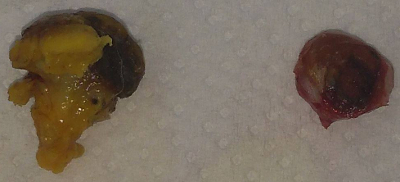
Below: Some bumblefoot infections can be very large.

Stage 3 - Bandaging the foot with colloidal dressings or manuka honey to keep the wound clean and moist until it heals fully.
Below: A clean bandaged chickens foot.
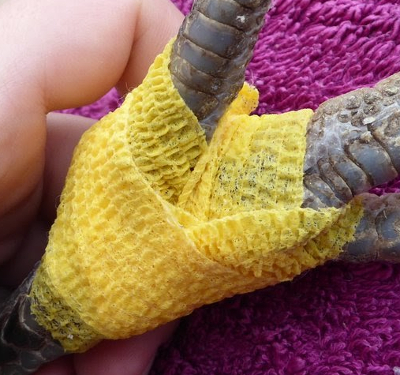
Stage 4 - Treatment also consists of changing the condition in your setup so as to minimise the risks of it happening again.
Chickens with Bumblefoot should be quarantined and not allowed to perch for at least 2 weeks until the foot has healed.
What antibiotic treats Bumblefoot?
Antibiotics is not normally prescribed for Bumblefoot in chickens unless it has spread to the bones or joints.
Tricide Neo soaking and topical antibiotic creams have some use. Cloxacillin is used if the infection has spread.
Treatment is removal of the abscess, cleaning and regular changes of dressings.
Are there natural treatments for Bumblefoot ?
For grade 1 and 2 Bumblefoot, ie. before the infection has entered the foot, natural treatments are the best.
Separate the bird from the flock and:
- Clean the foot and soaking with Epsom salts.
- Bandaging the foot with Colloidal dressings or medical (Manuka) honey. Soak, dry, gauze bandage, wrap and change daily.
- A drop or two of Lavender essential oil on the dressings is know to help wound healing.
Beyond grade or stage 3 Bumblefoot should be treated by a professional rather than resorting to natural methods. Natural methods of treatment should still be used at all stages as supportive measures.
Does Bumblefoot need to be treated by a veterinarian?
Yes and no. The early stages should be treated straight away at home by separating the birds to a hospital enclosure, cleaning, soaking in Epsom salts and covering the wound with clean sterile dressing every day.
I have both treated it myself and seen many people treat the condition themselves and as long as you have access to:
- Clean sterile instruments, work area and dressings.
- A willing volunteer to hold the chicken.
- A strong stomach. There will be blood and in most cases, quite a smell.
- The necessary antibiotics.
A bad case, infected bone or a spread of infection really needs to be seen by a Vet.
Below: Infections that have got into the internal tissues of the foot need professional treatment. This one has left multiple sores all over the foot.
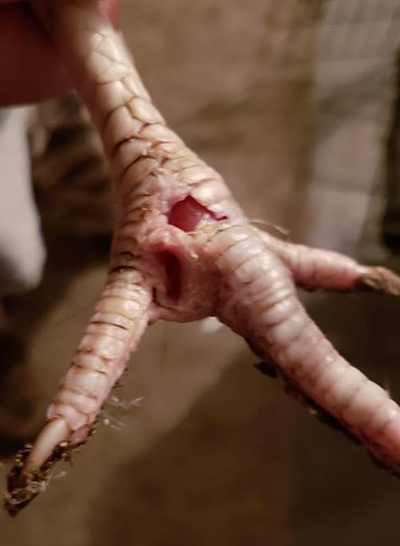
I have taken chickens to see the veterinarian for foot infections as well. The secret is knowing what you are capable of dealing with before you start.
Doing surgery on chickens is traumatic for everyone involved. Chickens don't tolerate anaesthesia well. Local anaesthetic can cause heart problems and failure in chickens and general is difficult as well.
How long should I keep her feet covered?
Till the wound has healed completely. This may take 2 to 4 weeks depending on the severity of the infection in the foot.
Should she separate her from the rest of the flock?
It is wise to separate sick and injured chickens from the flock. The other birds may pull at the bandage and if you chicken has a painful foot she may not be getting to the food and water regularly.
You should also make sure the chicken is not allowed to perch until the foot is healed.
Can Bumblefoot kill a chicken?
Bumblefoot is rarely fatal in chickens but extreme and untreated cases can kill birds. In my experience having sore feet can make them not want to move and they lose condition by not eating, perching and dust bathing.
Bumblefoot can kill poultry if:
- The feet are so damaged, infected or so sore the chicken can't move to eat or drink.
- The infection spreads or gets into the bone - chicken bones are hollow.
So yes a chicken can die from bumblefoot but it is very unlikely if treated.
Are the eggs laid by a hen with Bumblefoot OK to eat?
The eggs laid by a hen with Bumblefoot are fine to eat unless she is having a chemical or antibiotic treatment.
All treatments have egg withdrawal periods. Antibiotics are normally 1 to 7 days.
Do chickens have feeling in their feet?
Chicken feet are cleverly evolved things. They have a network of small blood vessels that acts like a heat exchanger . It allows the feet to work normally even when its cold. The downside of this is if the feet are injured they have a tendency to become infected easily.
Chickens do have feeling in their feet.
Is Bumblefoot contagious to other chickens?
No. Not contagious as such. One chicken can't catch bumblefoot from another. If one of your birds has it that makes it much more likely that others will get it too.
The bacteria are found everywhere. If your chickens have suffered it before than the conditions that caused it are present in you coop, run or pasture.
Are some poultry breeds more susceptible to Bumblefoot?
Yes. I have found the extra toes on Silkies and breeds with feathered feet are more likely to suffer with Bumblefoot, foot bubble or ulcerative pododermatitis.
Below: Breeds that have feathered feet may be more likely to get infected.
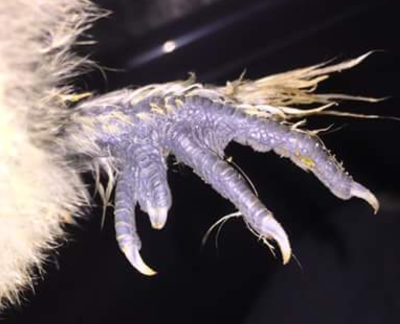
As a rule the conditions the chickens are kept in is much more of a concern than the breed.
Why do my chickens keep getting Bumblefoot?
Your chickens keep getting the infected feet because the conditions in your coop and run are causing cuts on the feet.
How do you prevent Bumblefoot?
As with most parts of chicken keeping prevention is always better and cheaper than a cure.
- Make sure perches, roosts and nest box edges are rounded off.
- Have enough space so the birds are not fighting and stressed.
- Improve the drainage of the land.
- Give the chickens access to fresh pasture and move them around regularly to allow the land to recover.
- Add a thick layer of sand in the run and cover to keep the rain and damp off.
- Allow more free range time.
- Trim nails and inspect feet at least once a month.
- Treat for mites as a precaution.
- Improve the hygiene and cleanliness of the coop or change the bedding or floor covering to dry sand or deep litter.
- Feed a balanced diet.
Can humans get Bumblefoot?
Humans can get infected feet but you can't catch Bumblefoot from your chickens. The abscess is infected with bacteria so care should be used when handling and treating birds.
Can ducks and other poultry get Bumblefoot?
Bumblefoot is a common infection for domesticated poultry and waterfowl such as guinea fowl, chickens, ducks and quail.
Constant walking on hard, rough, or sharp surfaces means poultry develop small wounds on the bottom of their feet. So yes all birds can get Bumblefoot.
Below: Ducks and other poultry can get bumblefoot.
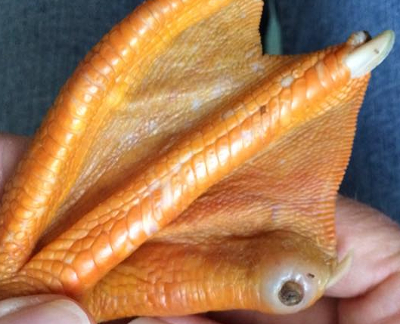
Ducks kept out of water on hard ground may be more susceptible.
What is the prognosis for Bumblefoot?
Very good if treated quickly. If allowed to fester and progress then the prognosis gets worse. Once it gets into the bones the prognosis for bumblefoot in chickens is poor.
Below: Bumblefoot beginning to heal.
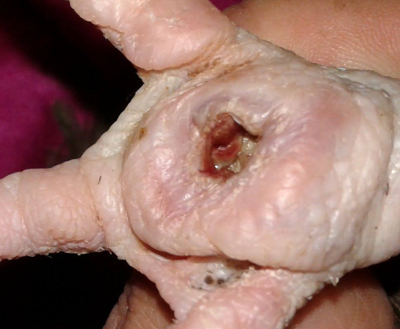
If your chicken is limping but does not have Bumblefoot then take a look at the sick chickens symptom checker - https://cluckin.net/the-sick-chicken-symptom-checker.html , or what is wrong with my chickens feet. Opens in a new window.
